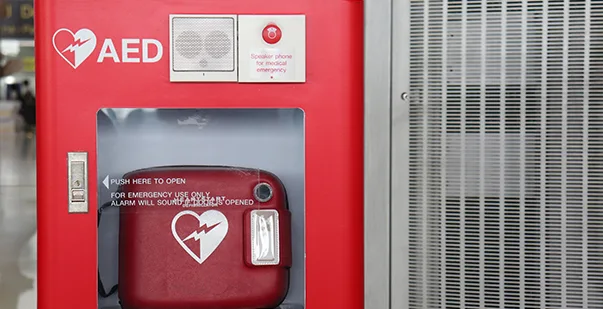Table of Contents:
- Introduction
- Understanding The Role of AEDs
- AED Requirements By State – An Overview
- Where are AEDs Required?
- What States Require AEDs in Schools?
- Ensure to be Well-Equipped to Save Lives
Introduction
AEDs (Automated External Defibrillators) have come a long way since their inception. These life-saving devices are becoming more versatile and accessible to both healthcare professionals and laypeople. As AEDs become increasingly present in our daily lives, it is important to evaluate the AED requirements by state to navigate the legal and regulatory landscape. By familiarizing yourself with these regulations, you can ensure compliance with AED laws in the event of an emergency. Read on to learn more!
Master ACLS Now
Get ACLS certified with confidence
Understanding The Role of AEDs
An Automated External Defibrillator (AED) is a medical device designed to assess heart rhythm and deliver an electric shock to victims of cardiac arrest in order to restore normal heart function. Cardiac arrest occurs when ventricular fibrillation (an uncoordinated heart rhythm) occurs, or when the heart stops beating altogether.
Without immediate medical attention, the victim will collapse, lose consciousness, become unresponsive, and may eventually die. Cardiac arrest can strike without warning, even in individuals with no prior history of heart disease. The chances of survival from sudden cardiac arrest decrease with each minute that passes without CPR or the use of an AED.
AED Requirements By State – An Overview
Are you wondering are AEDs required by law? Yes, they are. However, AED laws vary from state to state in the United States, with each state having its own legislation and regulations regarding the deployment and use of these life-saving devices. These laws promote the widespread adoption and effective use of AEDs, ultimately contributing to higher survival rates across the nation.
The regulations surrounding AED requirements are shaped by a combination of legislative processes, regulatory agencies, and healthcare standards bodies. State legislatures enact laws mandating AEDs in specific settings, often based on recommendations from healthcare professionals, emergency medical services, and public health experiences. Additionally, regulatory agencies and healthcare organizations may issue standards and guidelines to ensure the proper installation, maintenance, and use of AEDs.
Master ACLS Now
Get ACLS certified with confidence
Critical Aspects of AED Laws
State laws typically cover several critical aspects to ensure the effective implementation and maintenance of AED programs. These include:
- AED maintenance – Most AED laws emphasize the importance of maintaining the device, outlining specific requirements for regular maintenance and testing. This ensures the device’s optimal functioning and readiness for use in emergencies. In some states, proper maintenance and routine checks are mandatory to confirm that the devices are in ideal working condition when needed.
- CPR/ AED training- Another aspect covered by state AED laws by state. Many states in the U.S. have made it mandatory for every potential AED user, including employees in public places or designated EMTs, to undergo proper CPR/AED training. Comprehensive training ensures that individuals have the necessary knowledge and skills to administer first aid effectively during cardiac emergencies.
- AED Program Registration – Some state laws require the registration of AED programs. Businesses or organizations that have deployed AEDs on their premises may need to register them with relevant authorities. This registration helps authorities track the number and location of devices within their jurisdiction, aiding emergency services by directing responders to the nearest AED.
- AED Placement Reporting – AED placement reporting is often mandated by state laws, requiring businesses and organizations to report the exact locations of their AEDs. This information is valuable for dispatchers and first responders, enabling them to quickly locate and use the AEDs in critical situations.
- Medical Director – Medical direction is another important parameter in AED laws by state. It involves collaborating with medical professionals who can provide insights and guidance for AED programs. This ensures that the program adheres to the latest medical protocols, follows best practices, and operates within an appropriate legal framework.
- AED Use Reporting – In certain cases, state law requires the reporting of AED usage within premises. These laws mandate that incidents involving AED deployment be documented for relevant authorities. This helps monitor the effectiveness of AED programs and identify areas for improvement.
- AED Program Documentation – AED program documentation is also essential. Some states require organizations to maintain specific records related to their AED training, maintenance, and deployment. Proper documentation ensures compliance with state laws and helps organizations review the effectiveness of their AED programs and identify opportunities for improvement.
In addition to these parameters, AED requirements by state may also include other specific provisions. These could involve liability protection for AED users, funding opportunities for acquiring AEDs in public spaces, or guidelines for public awareness campaigns to promote the importance of AEDs and CPR training.
Where are AEDs Required?
AED requirements have become mandatory in public buildings in many states and by the federal government. For example, in California, health clubs and certain new construction sites are required to have AEDs. This underscores the state’s commitment to public health and safety, especially in settings with a higher risk of sudden cardiac arrest due to physical exertion or other factors.
In Colorado, dental offices where anesthesia is administered are mandated to have AEDs, with strict requirements for training and registration. This reflects the recognition of potential risks associated with medical procedures involving anesthesia and the importance of immediate access to life-saving interventions in such settings.
Here’s a brief overview of locations that require AEDs based on state:
| State Name | Required AED Locations |
| Alabama | Dialysis Centres |
| California | Health clubs
some types of new construction |
| Colorado | Dental offices where anesthesia is administered |
| Connecticut | Golf courses |
| Florida | Dental offices where anesthesia is administered |
| Illinois | Health clubs
Dental offices where anesthesia is administered Racing and gaming facilities |
| Iowa | Racing and gaming facilities |
| Maryland | Public swimming pools |
| New Hampshire | Dialysis Centre |
| New York | Dental offices where anesthesia is administered
Open surf beaches |
| Pennsylvania | Coal mines
Health clubs |
| Rhode Island | Any facility with a capacity of over 300 people |
Master ACLS Now
Get ACLS certified with confidence
What States Require AEDs in Schools?
Most school districts appreciate the importance of AED code requirements, but many struggle to afford the devices. Few states are willing to pass legislation that mandates schools to incur this cost. On any given day, approximately 24.8% of the U.S population can be found in schools. Given this figure and the prevalence of emergencies among both adults and students, schools should be prioritized for life-saving defibrillators.
But are AEDs required by law? According to the 2023 proposed Access to AEDs Act, laws now extend to all 50 states, including sporting events and campus functions. The legislation, which has bipartisan support, aims to authorize grant programs to support AED training and procedures on a national level.
Some states have mandatory AED laws for schools, along with widespread training, while others have less stringent policies, leaving the decision up to school management. Here’s an overview of states with AED requirements for schools:
| State Name | AED Requirement |
| Alabama | AEDs are mandatory in all K-12 public schools and must be regularly inspected and maintained. Schools are also encouraged to provide training for personnel on AED use. |
| Arkansas | All school campuses are required to have an AED on-site as well as adequately trained personnel. The state provides grants and fundraisers to help schools acquire and maintain AEDs. |
| California | California Education Code requires at least one AED in all public and charter schools with inter-school athletic programs. There are also recommendations for trainers and coaches at athletic events to be trained in handling SCA emergencies. |
| Connecticut | Each school board is required to facilitate the placement of an AED in every school and ensure proper AED and CPR training. The law mandates that an AED be available during normal school hours, athletic events, and school-sponsored events. |
| Florida | Florida was the first state to enact AED laws in schools, requiring an operational AED on school grounds at all times. Every school must also train employees to appreciate life-saving skills to use of an AED and basic first aid. |
| Georgia | Every public high school is required to have at least one AED on campus with school-wide access. The state also emphasizes CPR and AED training for students. |
| Kentucky | All public schools are required to have AEDs on-site for high school practices and athletic sports events. High school coaches must also be trained in CPR and AED use. |
| Massachusetts | Each school must have an AED on the premises for all school-sponsored athletic events. A trained individual certified in CPR and AED use must be present on school grounds. |
| New Jersey | Janet’s Law requires all schools to have an AED on their property in an unlocked location with clear signage at all times. Designated trained staff must be present at all athletic events and practices. |
| New York | Louis’ Law mandates that every public and charter school have AEDs on campus and that personnel are trained in their use. |
| Texas | Each school is required to have at least one AED on every campus, with trained employees present at any gathering with a large number of students. Students must also be trained in CPR and AED use between grades 7 and 12. |
| West Virginia | In memory of Alex Miller, a football player who lost his life during sports activities, every public school in the state is required to have an AED present at all sporting events. |
Ensure to be Well-Equipped to Save Lives
Automated External Defibrillators (AEDs) are vital tools for saving lives during sudden cardiac arrests. However, their accessibility and regulations vary across states in the United States. Understanding the laws concerning defibrillators allows you to use the device without worrying about any unforeseen legal repercussions.
Remember, acquiring an AED is not just a purchase; it’s an investment in saving lives. By making informed decisions and staying updated with AED requirements by state and the latest guidelines, you can ensure that you are well-prepared to respond effectively in any emergency situation.







